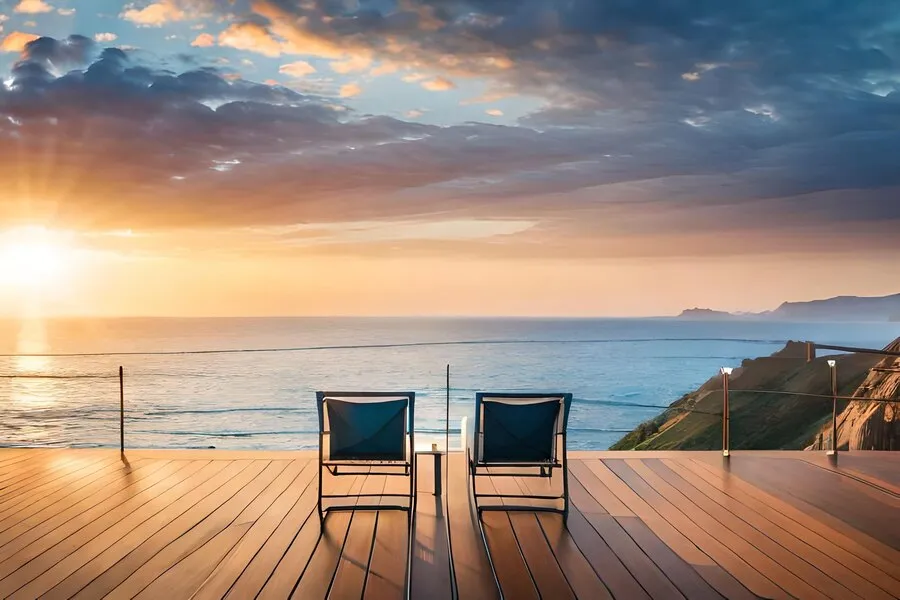Table of Contents
Key Takeaways
Building a coastal deck involves considering local weather, choosing suitable materials, and integrating style with functionality. Emphasizing sustainability can enhance the long-term value and aesthetic of your outdoor space.
Understanding Coastal Deck Challenges
Building a deck in coastal areas comes with unique challenges like saltwater corrosion, high humidity, and powerful winds. These environmental factors can significantly affect your deck’s longevity and structural integrity. Homeowners must consider the salty air that accelerates the rusting process in metal fasteners and the swelling of wood due to high humidity. The constant exposure to these elements means extra precautions are necessary to ensure a durable construction. Opting for functional layouts for coastal decks can significantly assist in overcoming these challenges. Implementing design strategies and using materials suited explicitly for coastal environments can help craft a resilient deck that stands the test of time.
Local weather patterns and environmental factors require careful selection of materials and designs. Enhancements that can be implemented to strengthen a coastal deck include:
- Railings resistant to wind.
- Fasteners that do not rust.
- Finishes that are resistant to UV rays.
Understanding these factors can aid in crafting a structure that meets aesthetic goals and provides long-term durability and safety.
Choosing Durable and Sustainable Materials
One of the most crucial decisions in deck building is material selection. Opting for durable, sustainable materials like composite decking or pressure-treated wood can withstand harsh coastal conditions. These materials are created to repel moisture and avoid warping and rot. Composite decking, comprising a mixture of wood fibers and plastic, provides the appearance of authentic wood without the requirement for ongoing upkeep. Additionally, materials with certifications from organizations can ensure eco-friendliness, guaranteeing that the timber is sourced sustainably. Composite decking is favored for resisting moisture and minimal maintenance requirements. It doesn’t splinter, retains its color well, and typically comes with extended warranties. Conversely, pressure-treated wood offers a classic and natural look but requires regular upkeep to prevent rot and insect damage. Knowing deck design inspirations can help you balance appearance, eco-friendliness, and longevity, guaranteeing that your deck stays attractive and usable over the long term.
Balancing Style and Functionality
Creating a functional yet aesthetically pleasing deck involves thoughtful planning. Integrating built-in seating, outdoor kitchens, or a fire pit can add value and comfort to your deck space. These features enhance usability and provide a focal point for gatherings and relaxation. Remember, the style shouldn’t compromise functionality. Utilizing modular designs can help achieve both, offering flexibility and ease of use. This balance also extends to furniture and decor. Choose pieces that are both stylish and weather-resistant. For instance, teak furniture, renowned for its durability, and outdoor rugs, which can add warmth and style, are excellent choices for coastal environments.
Weatherproofing Your Coastal Deck
Weatherproofing is essential for coastal decks. It includes using water-resistant materials, applying sealants, and installing proper drainage systems. Sealants act as barriers against moisture, protecting wood from swelling and breaking down. Adequate drainage is equally important to prevent water pooling and causing structural damage. Regular maintenance, like checking for signs of damage and resealing surfaces, can extend the lifespan of your deck.
Furthermore, consider using shielded electrical outlets and corrosion-resistant fasteners to guarantee the safety and functionality of your deck. These measures can ensure the durability of your deck’s electrical components and overall structure, regardless of weather. Investing time in weatherproofing measures will save money and effort in the long run, preserving the beauty and usability of your coastal deck.
Incorporating Green Features
Adding green features like solar-powered lights, rainwater harvesting systems, and native vegetation can create an eco-friendly and sustainable deck. Solar-powered lights are not only energy-efficient but can also provide ambient lighting, enhancing the overall aesthetics of the deck at night. Rainwater harvesting systems can be used for gardening or cleaning, reducing dependency on other water sources. These features reduce environmental impact, lower maintenance costs, and enhance the outdoor living experience. Simple additions like potted native plants or a vertical garden can transform your deck into a green oasis. Indigenous plants are highly suited to the regional weather conditions and need minimal water and attention, making them an excellent option for landscaping that requires little upkeep. They support local biodiversity and blend your outdoor space with the natural coastal environment, creating a harmonious and sustainable retreat.
Maintenance Tips and Tricks
Maintenance is vital to preserving your coastal deck. Simple practices like sweeping off debris, washing surfaces with a mild detergent, and inspecting for pests can go a long way. These routine tasks prevent dirt and mildew buildup, keeping your deck looking fresh and new. Additionally, scheduling professional inspections periodically can help identify and address potential issues early, such as loose fasteners or structural wear. Waterproof covers for furniture and routine inspections of the deck’s structural integrity are also prudent measures. Covers protect furniture from harsh weather, extending its lifespan, while structural inspections ensure safety and durability. By following these maintenance suggestions, you can have a well-kept and appealing deck all year.
Also Read: From Drip to Disaster: How to Respond Quickly to a Plumbing Emergency
Design Inspiration and Trends
Current trends include minimalist design, neutral colors, and the integration of smart home technologies. The minimalist design emphasizes simple lines, tidy spaces, and practical decorations to produce a calm and elegant outdoor area. Platforms offer various resources on contemporary outdoor living designs that can spark creativity. By embracing modern trends and timeless design principles, you can create a coastal deck that is both functional and fashionable. The fusion of aesthetic appeal with practicality enhances your living space and adds value to your home, making your coastal deck a cherished part of your lifestyle.




